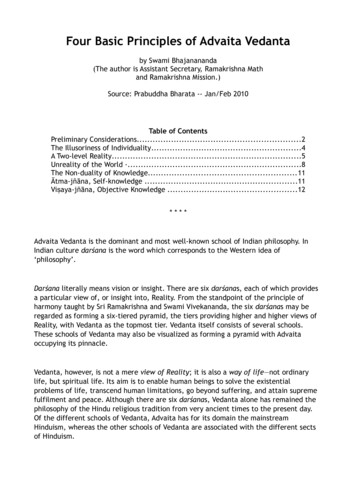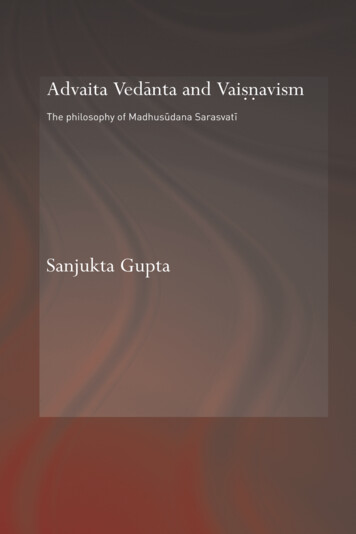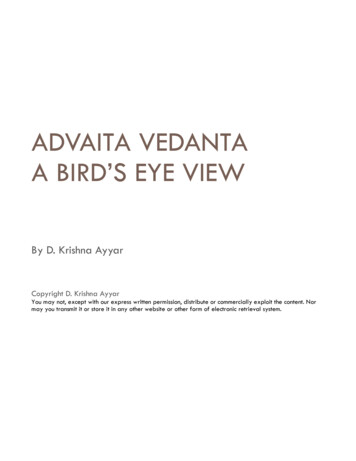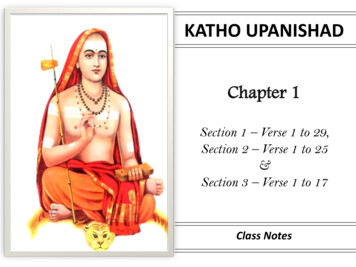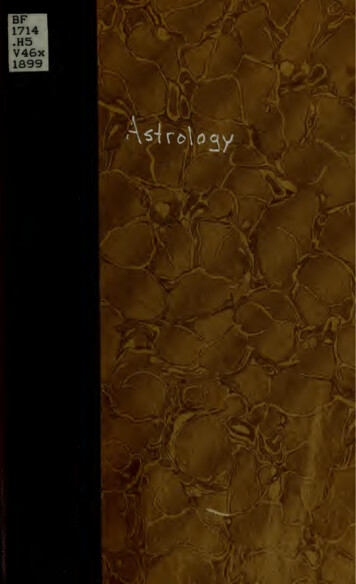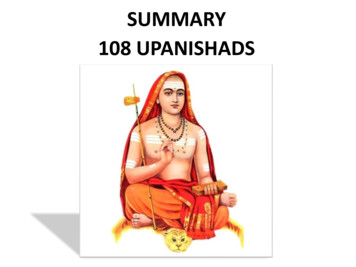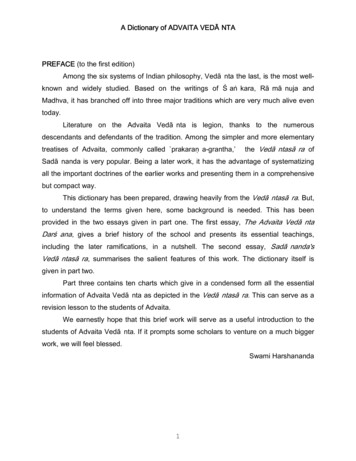
Transcription
A Dictionary of ADVAITA VEDĀVEDĀ NTAPREFACE (to the first edition)Among the six systems of Indian philosophy, Vedā nta the last, is the most wellknown and widely studied. Based on the writings of Ś aṅ kara, Rā mā nuja andMadhva, it has branched off into three major traditions which are very much alive eventoday.Literature on the Advaita Vedā nta is legion, thanks to the numerousdescendants and defendants of the tradition. Among the simpler and more elementarytreatises of Advaita, commonly called prakaraṇ a-grantha,’the Vedā ntasā ra ofSadā nanda is very popular. Being a later work, it has the advantage of systematizingall the important doctrines of the earlier works and presenting them in a comprehensivebut compact way.This dictionary has been prepared, drawing heavily from the Vedā ntasā ra. But,to understand the terms given here, some background is needed. This has beenprovided in the two essays given in part one. The first essay, The Advaita Vedā ntaDarś ana, gives a brief history of the school and presents its essential teachings,including the later ramifications, in a nutshell. The second essay, Sadā nanda'sVedā ntasā ra, summarises the salient features of this work. The dictionary itself isgiven in part two.Part three contains ten charts which give in a condensed form all the essentialinformation of Advaita Vedā nta as depicted in the Vedā ntasā ra. This can serve as arevision lesson to the students of Advaita.We earnestly hope that this brief work will serve as a useful introduction to thestudents of Advaita Vedā nta. If it prompts some scholars to venture on a much biggerwork, we will feel blessed.Swami Harshananda1
PREFACE (to the second edition)The first edition brought out in December 1990 has been well-received by thestudents of Vedā nta. Since it had been based entirely on the Vedā ntasā ra ofSadā nanda, many important terms and words commonly used in the Advaita Vedā ntaliterature, but not found in that book, had been omitted from its purview. Consideringthis as a lacuna and with a view to expanding its scope so that it proves to be moreuseful to the serious students of Vedā nta, the work has now been expanded by addinga little more than seventy new items. The arrangement of the subject matter has alsobeen altered to bring it in consonance with the title of the work.We trust that this enlarged edition will be welcomed even more.Swami Harshananda2
CONTENTSINTRODUCTIONADVAITA VEDĀ NTA DARŚ ANAPREAMBLEDARŚ ANASVEDĀ NTA DARŚ ANAADVAITA VEDĀ NTABrahman, the Only RealityAnirvacanī ya Khyā tiAjñā na or AvidyāMā yāThree Degrees of RealityCreationJī vaSā dhanā s and MuktiJī vanmukti and VidehamuktiLocus of AvidyāPOST-Ś AṄ KARA ADVAITACONCLUSIONA DICTIONARY OF ADVAITA VEDĀ NTAAPPENDIXSADĀ NANDA'S VEDĀ NTASĀ RACHARTS3
Key to Transliteration and Pronunciation – sounds likeअ, a-o in son,ठ ṭ h-th in ant-hillआ , ā -a in master,ड ḍ -d in denइ i-i in if,ढ ḍ h-dh in godhoodई ī -ee in feel,ण ṇ -n in underउ u-u in full,त t-t in Frenchऊ ū -oo in boot, थथ th-th in thumbऋ ṛ -somewhat between r and ri, द d-th in thenध dh-the in breatheए e-ay in May,न n-n in notऐ ai-y in my,प p-p in penओ o-o in oh,फ ph-ph in loop-holeऔ au-ow in now,ब b-b in bagक k-k in keen,भ bh-bh in abhorख kh-ckh in blockhead,म m-m in motherग g-g (hard) in go,य y-y in yardघ gh-gh in log-hut,र r-r in runङ ṅ -ng in singer,ल l-l in luckच c-ch in chain,व v-v in avertछ ch-chh in catch him,श ś -sh in reich (German)ज j-j in judge,ष ṣ -sh in showझ jh-dgeh in hedgehog,स s-in sunञ ñ-n (somewhat) as in French,, ह h-in hotट ṭ -t in ten,॰ ṁ -m in sum,:ḥ -h in half4
INTRODUCTIONADVAITAADVAITA VEDĀVEDĀ NTA DARŚDARŚ ANAPREAMBLEMan is often described as a rational animal. Once the animal in him is reasonablysatisfied by the provision of basic biological and some psychological needs, the rationalpart gets an opportunity to evolve to higher levels. Philosophy, including metaphysics, isone of the highest aspects of this evolution.DARŚDARŚ ANASThe Indian philosophical systems have developed not only as a result ofintellectual speculation but also of mystical intuition. Hence the name darś ana' (lit., seeing'), usually applied to them. The topics most commonly discussed by thesedarś anas are generally four: (a) nature of the physical world, its origin and evolution;(b) nature of man and other living beings; (c) existence of God, his nature andattributes; (d) the goal of human life and the way of attaining it.Different standpoints and differing views of these topics of discussion havenaturally led to a variety of schools. These schools are broadly divided into two classes:the ā stika and the nā stika. The former accept the authority of the Vedas whereas thelatter do not.VEDĀVEDĀ NTA DARŚDARŚ ANAThe Vedā nta Darś ana is the last of the former schools but has gained the mostimportant place among them. A judicious combination of reasoning and acceptance ofthe authority of the Vedas, as also a long unbroken tradition, are responsible for itsgaining the prominent place.Though the prasthā natraya' ( the three great paths') viz., the Upaniṣ ads, theBrahmasū tras and the Bhagavadgī tā , are the basis of the Vedā nta Darś ana, it isthe Brahmasū tras (also called Vedā ntasū tras and Ś ā rī rakasū tras ) ofBā darā yaṇ a Vyā sa that occupies the key position. The sū tras (aphorisms) beingquite terse and often ambiguous, have naturally led to widely differing interpretations,5
resulting in the three well-known systems of Vedā nta viz., Advaita, Viś iṣ ṭ ā dvaitaand Dvaita.The word Vedā nta' itself means the end or the essence of the Vedas.' It is theUpaniṣ ads that mainly comprise the Vedā nta since they normally form the last part ofthe Vedic literature and contain the quintessence of their teaching.ADVAITA VEDĀVEDĀ NTAThe Advaita Vedā nta Darś ana owes its systematisation as a formidabledoctrine, to Gauḍ apā da (7th-8th cent. A.D. ) who wrote his famous Kā rikā s on theMā ṇ ḍ ū kyopaniṣ ad, and Ś aṅ kara ( A.D. 788-820). Ś aṅ kara's commentaries onthe Prasthā natraya as also a few independent treatises form the bedrock on which thelater Advaitins built their edifices.Brahman, the only Reality Advaita' means non-dual,' one without a second'. The system derives thisnomenclature from the fact that it recognises Brahman (the Absolute) as the only realityand denies permanent reality to the world as also to the individual souls.The entire edifice of Advaita metaphysics is built upon the foundation that Brahman isthe only reality, brahma satyam.' This premise is based firmly on thefamousUpaniṣ adic statement sadeva somya idamagra ā sī t, ekamevā dvitī yam,' Dear(Ś vetaketu), in the beginning (before creation) Reality (or Brahman) alone existed,the one without a second' (Chā ndogya Upaniṣ ad 6.2.1).AnirvacanīAnirvacanī ya KhyāKhyā tiHowever, the world of multiplicity is a matter of our day-to-day experience. Henceit becomes necessary to offer an explanation as to how Brahman, the one without asecond, appears as this world of multiple names and forms. The explanation offered byAdvaita is anirvacanī yakhyā ti, its theory of erroneous cognition, which defies logic.Perceiving silver in nacre in moonlight or a snake in a rope in insufficient light are thestock examples given by the Advaitins. In both cases there is an erroneous perceptionbrought about by the impression of silver and snake from an earlier idea of the same,now superimposed upon nacre and rope under conditions favourable to the error. This6
superimposition called adhyā sa' or adhyā ropa,' is responsible for the mithyā jñā na(false knowledge) that the object perceived is silver or snake.The silver or the snake perceived is neither sat' (real) nor asat' (unreal). It is not asat' or unreal like the son of a barren woman' since it is actually perceived. Neither isit sat' or real since it disappears as soon as the substratum (the nacre or the rope) isperceived as it is. To explain such a peculiar phenomenon Ś aṅ kara creates, out oflogical necessity, a third type of perceived objects which is sad-asad-vilakṣ aṇ a'(different from both the real and the unreal). The khyā ti' or the cognition itself isdescribed as anirvacanī ya,' incapable of any precise definition or description.AjñAjñā na or AvidyāAvidyāThe basic cause of this erroneous perception is termed as ajñā na or avidyā(ignorance) which is said to be bhā varū pa (existent) and is endowed with two ś aktisor powers viz., ā varaṇ aś akti' (veiling power) and vikṣ epaś akti' (transformingpower). It veils the true nature of nacre and rope, and shows up silver and snake in theirplace by apparently transforming them. Such an apparently transformed object is calleda vivarta' of the original and the theory that propounds this is known as Vivartavā da.Since this avidyā does not make the nacre and the rope completely disappear fromview, but only makes them appear as something else, it is described as bhā varū pa'or existent.M ā yāAn attempt may now be made to explain how this world of duality has evolvedout of the nondual Reality called Brahman in the Upaniṣ ads. The world of duality canbe broadly divided into dṛ k' (the seer) and dṛ ś ya' (the seen). Both these, again, aredivided into the innumerable living beings (jī vas) and countless objects of creation.How does Brahman the Absolute, the one without a second, the indivisible Reality,appear divided into innumerable beings on the one side and countless objects on theother? It is avidyā that causes the one Ā tman (the Self) incidentally, the Upaniṣ adsuse both words, Ā man and Brahman, to indicate the same Reality-appear as manyjī vas and it is mā yā that causes the world of phenomena. Mā yā is avidyā at the7
cosmic level.Three Degrees of RealityŚ aṅ kara accepts three degrees of reality. The first, known as prā tibhā sikasatya' (apparent truth, illusory appearance) is illustrated in the wrong perception of silverin nacre or a snake in a rope. The second, called vyā vahā rika-satya' is illustrated bythis world of our day-to-day experience. This world appearance has a much higherdegree of reality and lasts till one gets ā tmajñā na or brahmajñā na, realization ofTruth. It is satya or true for all purposes of vyavahā ra i.e., day-to-day existence orpractical life. The third, designated as pā ramā rthika-satya,' is the highest Truth andthe only truth that really exists. It is Brahman or Ā tman, which is nirguṇ a (withoutattributes) and nirā kā ra (without forms), hence incapable of being described except ina negative way ( neti, neti'á not this, not this').CreationBrahman associated with mā yā is Saguṇ a Brahman (Brahman with attributes)or Ī ś vara (Lord of creation, God). It is this aspect of Brahman that is responsible forcreation, preservation and destruction of the world. As for the actual order of evolutionof the created world, the descriptions given in the Upaniṣ ads are accepted.For Ś aṅ kara who holds that the world process is only a vivarta (illusory appearance)due to adhyā sa (superimposition on Brahman), the very attempt to describe thevarious steps of evolution is a futile exercise. However, since the ś ruti (revealedscripture, the Upaniṣ ads) has done so, a place of honour must somehow be accordedto it. So he characterises such descriptions as giving taṭ asthalakṣ aṇ a' (accidental orcasual characteristics) of Brahman helping us to be directed towards it, even as thebranch of a tree helps us to locate the crescent in the sky. On the other hand, Brahmanas it is, can be comprehended only through its svarū palakṣ aṇ a' (integral or essentialcharacteristics),whichis sat-cit-ā nanda.' Sat'(eternalreality), cit'(pureconsciousness), and ā nanda' (unalloyed bliss) are not really its characteristics but itsvery essence.8
Jī vaThis Brahman or Ā tman which is sat-cit-ā nanda, has inexplicably got itselfinvolved in the body-mind complex, the involvement being due to avidyā . Since theorigin of this involvement can never be logically or satisfactorily explained, avidyā isstated to be anā di or beginningless. The involved Ā tman is designated as jī va.'This jī va, the Ā tman in bondage, has five koś as or sheaths, three ś arī ras orbodies, performs actions motivated by desires, experiences pleasure and pain due tokarma and undergoes transmigration until liberation. Ś aṅ kara declares that this jī va,when shorn of its upā dhis or limiting adjuncts like the body and the mind, is identicalwith Brahman, since its essential nature also is sat-cit-ā nanda.Sā dhanas and MuktiThe main trouble with the Ā tman become jī va is the tā dā tmya or falseidentification with the mind and the body, brought about by adhyā ropa or adhyā sa(superimposition). Hence the only way of remedying it is by apavā da ordesuperimposition, by denying this identification. For this, one has first to prepareoneself by the preliminary fourfold discipline or sā dhanacatuṣ ṭ aya viz., viveka(discrimination between the eternal and the non-eternal), vairā gya (dispassion),ś amā diṣ aṭ ka (cultivation of the six virtues like self-control) and mumukṣ utva(desire for liberation). Then one has to approach a competent guru (spiritual preceptor)and learn the truth from him by ś ravaṇ a (hearing), manana (reflection) andnididhyā sana (contemplation). The most important part of the guru's teaching will be inthe form of mahā vā kyā s' (great sentences) like tat tvam asi' (That thou art') or aham brahmā smi' ( I am Brahman'). Ś ravaṇ a and manana produce the deeprootedconviction that one is the spirit. Hence in nididhyā sana, desuperimposition in the formof I am not the body, nor the sense-organs, nor the mind, nor even the ego' and so on,can be practised leading ultimately to the realization that one is the Ā tman. Thisrealization resulting in mukti or liberation can be had even while one is living in thisbody. It is known as jī vanmukti.' He will attain videhamukti' (liberation from futurebodies) after the body falls off, the continuance of
Literature on the Advaita Vedānta is legion, thanks to the numerous descendants and defendants of the tradition. Among the simpler and more elementary treatises of Advaita, commonly called prakaraṇ a-grantha,’ the Vedā ntasā ra of Sadā nanda is very popular. Being a later work, it has the advantage of systematizing all the important doctrines of the earlier works and presenting them .
